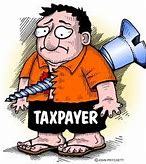
Uncle Sam has a series of collection methods in its arsenal, and two of the most common and aggressive tools are tax lien and levy. Sadly, Uncle Sam is far from being gentle with any taxpayer that defaults.
Tax liens and levies are two different processes; they come with few similarities. This article explores important things to know about both tax liens and levies and the differences.
What Warrants tax lien or levy, and who files it?
The federal or state tax authority can file a tax line against you if you neglect your tax obligations. The exact measure – whether tax lien or levy is a matter of the measure Uncle Sam feels is best for your exact tax situation.
IRS Tax Lien
This is a public record usually filed with the local court clerk authorizing Uncle Sam to claim the taxpayer's property. This makes the property serve as a security for the debt payment. If you accidentally forgot to pay your tax, the tax lien will be issued within five days of filing.
There are cases in which Uncle Sam gives creditors priority since you have secured property from them in the last 45 days. Bear in mind that the IRS Notice of Federal Line will be published in all Local Newspapers since it is a public record.
Effect of a Tax Lien
There are many ways a tax lien affects you. For example, your asset, credit, business and bankruptcy proceedings will all be affected.
Asset: the lien will be attached to all your asset, including future ones, if you did not get the lien off
Credit: any lien notice mars your credit rating as it will be reported to the Credit Bureau.
Business: With a tax lien, the government takes an interest in your business asset and properties
Bankruptcy: even after filing for bankruptcy, all your back taxes alongside the Federal Tax Lien notice will still be there
IRS Tax Levy
With a levy, Uncle Sam tries to seize your properties like real estate, cash in your account, personal properties, etc., ideally, and you will have a notice from Uncle Sam with 30 days validity of the intent to levy before the real action. This leaves you with some time to act and stop such a levy from actualizing.
Uncle Sam resorts to a tax levy when the taxpayer fails to respond to a series of collection actions, or Uncle Sam is concerned that some of your assets might be unavailable soon because of the sale. Thus, every asset in your name will be levied, and in most cases, they apply to:
Checking and savings account
Salary and wages account
Retirement account
Rental income
Pay for subcontractor
Accounts receivables
There are, however, provisions from the law that restrict Uncle Sam from having the levy on some asset or income source to prevent you from losing your entire asset.
Effect of a levy
Your debt amount usually determines the effect of a levy on you, which comes back to your exact tax debt. Uncle Sam will likely go through the easiest collection approach. The methods are:
Seizure of properties
1099 levies: tax levies on current receivables, not future ones
IRS bank levy – request to banks where you have an account to freeze your account
How to get out of a Tax Debt
A tax lien or levy is the last thing you want from Uncle Sam, as getting out of them is pretty complicated. However, an experienced tax professional might be able to help. A tax lien will only be removed when all tax debt is settled.
Tax liens and levies are two different things, and most times, a tax lien comes first before a levy. So even if Uncle Sam is yet to contact you, and you have tax debt, don’t wait until you start getting Uncle Sam’s notice before taking care of it. You might not know the series of steps they are taking to make life horrible for you financially.
FOR MORE INFORMATION ON HOW CARMEN GARCIA CAN BEST HELP YOU WITH YOUR TAX FILING NEEDS, PLEASE CLICK THE BLUE TAB ON THIS PAGE.
THANKS FOR VISITING.
Carmen Garcia